Polish Championship 2025: Paweł Teclaf and Klaudia Kulon claim titles
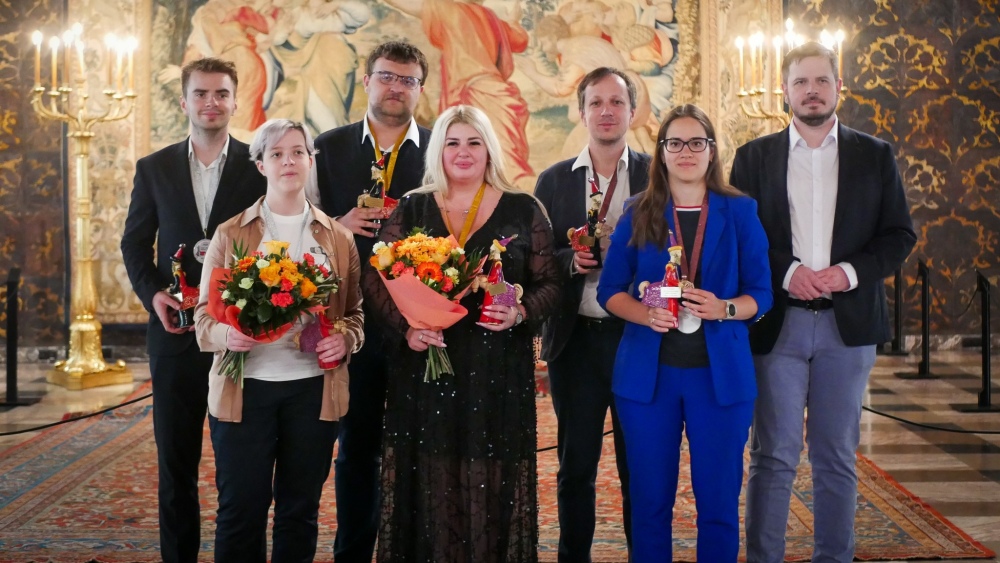
GM Paweł Teclaf and IM Klaudia Kulon are the new chess champions of Poland. Hailing from Kartuzy, the 21-year-old Teclaf claimed his maiden national title, while Kulon captured her second crown, repeating her 2021 success. Held at Kraków’s historic Wawel Castle from May 6-14, the 2025 PGE Polish Chess Championship featured both Open and Women’s sections. . Unlike several previous knockout editions, the 2025 competition followed a 10-player round-robin format. The total prize fund was 157,000 PLN, with top prizes of 30,000 PLN (approximately $8,000) awarded to the champions of both sections. The Open tournament proved to be a tightly contested event, culminating in a thrilling duel between Paweł Teclaf (pictured below, left) and Jakub Kosakowski (pictured below, right). Entering the final ninth round as joint leaders with 5.5/9, both players drew their games, to finish tied at 6/9. A rapid tiebreak match was played to determine the champion. After drawing the first game with the black pieces, Teclaf clinched the title by winning the second. Notably, he emerged the only undefeated player in the competition. The 2024 champion Radosław Wojtaszek completed the podium edging out Szymon Gumularz on better tiebreaks. Final Standings – Open In the Women’s event, Klaudia Kulon started strong with three straight wins and took an early lead, which she never relinquished. Although she stumbled in Round 4 with a loss to Oliwia Kiolbasa, Kulon bounced back with another three victories, securing the title with a round to spare. IM Aleksandra Maltsevskaya, the only undefeated player in the women’s section, delivered a consistent performance but managed only three wins, finishing in second place with 6/9. IM Alina Kashlinskaya and GM Monika Socko both scored 5.5/9, tying for third place. Kashlinskaya claimed the bronze medal on tiebreaks. Final Standings – Women Photos: Julia Michniak and Jakub Pietraszewski Official website: mp2025.pzszach.pl/
WGP Austria R08: Leaders Muzychuk and Zhu held to draws
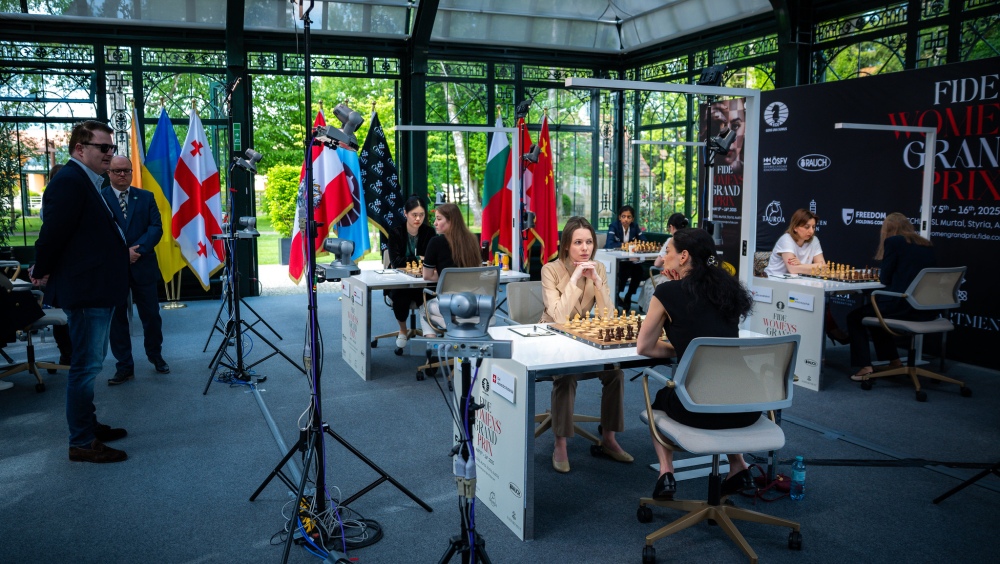
Anna Muzychuk’s momentum stalled with a fourth consecutive draw, but she remains level at the top after Olga Badelka halted Zhu Jiner’s five-game winning run. The race for first place remains wide open ahead of the final round. Tensions were running high at the orangery on the grounds of Gschlössl Murtal in Styria, as the penultimate round of the 2024/2025 FIDE Women’s Grand Prix series was about to start. Three of the five games ended in draws, while the two decisive encounters were marked by sharp swings and desperate time scrambles. Anna Muzychuk and Zhu Jiner remain tied for first as they head into the final round. Muzychuk will have the white pieces against Vaishali Rameshbabu and must win to have a shot at clinching both the tournament and the overall Women’s Grand Prix title — provided Zhu does not win her game. Zhu, on the other hand, can afford a draw but must avoid defeat with the black pieces against former world champion Alexandra Kosteniuk. The round started with a minute of silence. Earlier in the day, news broke that the long-serving president of the Austrian Chess Federation and member of the Honorary Praesidium of FIDE, Kurt Jungwirth, passed away at the age of 95. The first game to finish – after three hours and 20 minutes of play – was between Lela Javakhishvili and Anna Muzychuk. In the English Opening, White (Lela) was trying to make a breakthrough on the queenside. The Georgian was doing better on the clock, but the game was complicated and without any real chances for either side. A threefold repetition sealed a draw on move 28. Anna didn’t look very pleased as she left the venue. In the first part of the tournament, she had one draw (with her sister Mariya) and three victories. In the second part – four draws. Today’s result puts into question her chances of becoming the outright winner of the final leg of the Women’s Grand Prix, which is what she needs if she wants to win the series and secure a spot in the 2026 Women’s Candidates. The second leader of the tournament also drew. Playing the French Defence, Olga Badelka managed to stop Zhu Jiner’s run of five consecutive victories. The two relatively quickly progressed to an endgame with a pair of rooks and a pair of minor pieces. Although Zhu had an hour on the clock compared to Badelka’s 30 minutes after 25 moves, it was not enough to tip the balance in her favour in an equal position. Seeing that Anna drew, Zhu pressed on and even played a bit riskily, hoping that Badelka – who has not had a great tournament, would stumble. But Olga was confident in holding her ground. When nothing more could have been done, after three and a half hours and 43 moves, Zhu had to admit that it was time to call it a day. In the last round, she will have a tough challenge against the former world champion, Alexandra Kosteniuk. The sharpest and most intense game of the round – and possibly the entire tournament so far – happened between Nana Dzagnidze, who was White, and Nurgyul Salimova. According to the chessgames.com database, this was only the second game between the two. Previously, they met in 2021 during the World Blitz Championship in Almaty (Kazakhstan), from which Salimova emerged as the victor. Dzagnidze started with the English Opening and managed to get a slight advantage. As early as move 11, the game entered a sharp phase. White is better. Still, the most logical choice for Black was to secure her king by castling and for the game to run its course. Instead, Salimova embarked on an adventure which would see a very sharp exchange on board. 11…Nxe4? Taking the pawn but at what cost? After the cold-blooded 12.Qc2 Nxc3 13.Nc7+ Kd8 14.bxc3 Nd4 15.Qd2 Qa4 16.cxd4 Kxc7 and Black keeps a pawn but is severely underdeveloped and exposed. Instead, Dzagnidze made a weak move: 12.a3? and after Qa5 13.Qg4 Nxc3! 14.Qxg7 Nxb5+ 15.b4 Nxb4!! 16.Qxh8+ Ke7 17.bxc4 Qxb4+ 18.Kd1 Qd6+ 19.Kc2 (Ke1 was better) 19…Nd4+ 20.Kc3 Nc6! Black’s risky approach paid off – she got enough compensation and counterplay while White had to be careful because of her exposed king. By this point in the game, both had well under 20 minutes on the clock. By the time they reached the position below, both were in desperate time trouble. Black is in control. The best way to proceed was 32…Na1+ 33.Rxa1 Qb3+ 34.Kd3 c2+ 35.Kd2 cxd1=R+ 36.Rxd1 Qb4+. However, Salimova played 32…Qe4+? and after 33.Bd3 Qa4 it was equal again, as White could deliver a perpetual check with 34.Qg5+ Ke8 35.Qg8…. Instead, Nana played 34.Qxc3?? but Nurgyul immediately returned the favour with 34…Nc5+?? (after 34…Rb6, White has no defence against Black’s multiple threats) 35.Kd2 Qf4+ 36.Ke1 Nxd3 37.Qxd3 Rxb1 38.Rxb1 Ba6!? made with seconds on the clock. 38…Qxh2 recommended by the computer leads to an equal position. After 39.Qa3+ d6 40.Rb4 Qe5+ Both reached the first time control with White now being notably better. Ten moves later, Dzagnidze was completely winning. This was the longest game of the day, finishing after just under five hours of play. Despite being known for her time troubles, Dzagnidze is having a solid performance in the tournament. With just one loss, five draws and two wins – she is now on 4.5 and is in tied fourth place with Vaishali Rameshbabu who also drew today. Two games of round eight ended in a draw. In the Murphy Defence of the Ruy Lopez, Vaishali gained a slight initiative over Tan Zhongyi. However, after 25 moves, Vaishali was down to 28 minutes while Tan had more than an hour. Still, the young Indian GM played steadily, and by move 35 the two transitioned to an even rook endgame. Similarly to her round six win over Salimova, Tan tried to grind her opponent, in another effort to successfully drain blood from stone.
Vlastimil Hort (1944–2025)

Czech-German grandmaster Vlastimil Hort, one of the world’s strongest players during the 1960s and 1970s and a former world number six, has passed away at the age of 81. Vlastimil Hort was born on 12 January 1944 in Kladno, in the Protectorate of Bohemia and Moravia (now the Czech Republic). He learned chess at the age of five and immediately showed great potential. Hort progressed rapidly, making his debut for the Czechoslovak national team at the age of sixteen. A Grandmaster since 1965, Hort reached his peak in the 1970s. Playing for the “World” team in the famous “USSR vs. Rest of the World” match in 1970, he faced Lev Polugaevsky on board four and defeated him with a score of 2.5–1.5—one of the highlights of his career. In 1976, he finished third in the Manila Interzonal, earning a spot in the Candidates Tournament. His Candidates quarterfinal match against Boris Spassky became one of the most memorable demonstrations of sportsmanship in chess history. During the later stages of the match, Spassky fell ill and had used up all his allotted time-outs. Hort could have claimed victory by default, but instead, he offered Spassky one of his own time-outs, allowing the former World Champion to recover and continue. Spassky eventually won the match by a narrow margin. Photo: Icelandic Chess Federation A five-time Czechoslovak champion (1970, 1971, 1972, 1975, and 1977), Hort moved to West Germany in 1985 and went on to win the national championship of his new homeland in 1987, 1989, and 1991. Vlastimil Hort represented Czechoslovakia and later Germany in a total of 14 Chess Olympiads: for Czechoslovakia in 1960, 1962, 1964, 1966, 1968, 1970, 1972, 1974, 1980, 1982, and 1984, and for Germany in 1988, 1990, and 1992. Following his successful playing career, Hort became a beloved commentator and columnist. He appeared frequently alongside Grandmaster Helmut Pfleger in the popular television program Schach der Großmeister, which developed a broad and loyal following. FIDE extends its sincere condolences to Vlastimil Hort’s family, friends, and loved ones.
FIDE statement on suspending chess in Afghanistan

FIDE and the global chess community deeply regret the decision of the Afghan government to suspend chess over gambling concerns. FIDE is actively consulting the IOC, the Asian Chess Federation and other relevant sports and international bodies to find a constructive solution. We believe that chess is one of the most beautiful sports in the world, promoting hard work, patience, fairness, and openness. Beyond the board, chess is a powerful tool for community building and bringing people together. If there is a game, a sport that depends almost completely on skill and preparation, rather than chance, it is chess. Chess has a long and established presence in Afghanistan. In recent years, the game has thrived in the country, with more young people taking up chess. Suspending chess can harm its development and deny opportunities for future Afghan players to showcase their talent and represent their country on the global stage. FIDE will continue to follow developments closely, engaging in a constructive dialogue with the authorities, working with international sports organisations and other relevant stakeholders, to explore ways to have chess reinstated in Afghanistan as soon as possible.
WGP Austria R07: Zhu catches up with Anna Muzychuk in the race for the crown
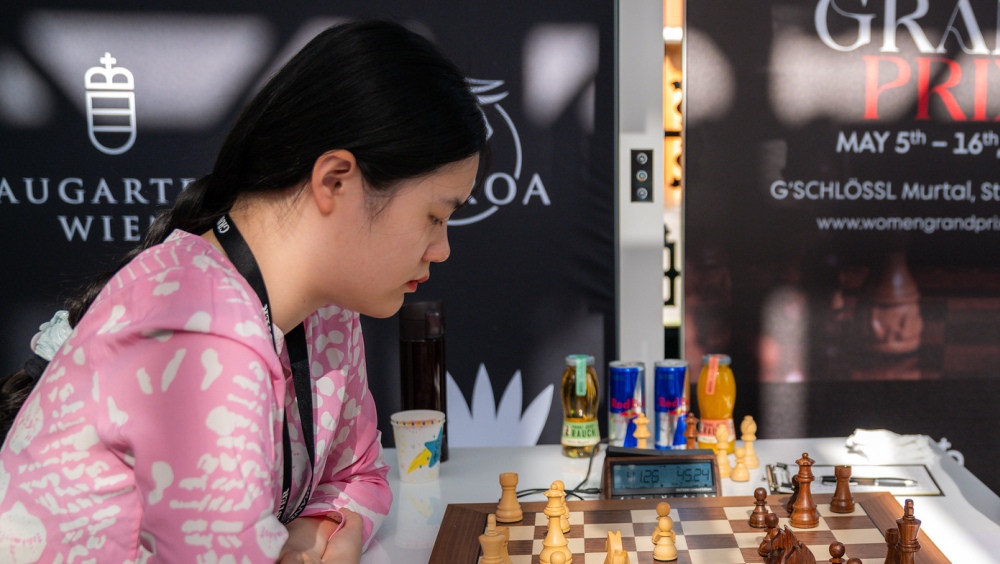
In a day of fast and sharp games, Zhu Jiner scored her fifth consecutive victory to tie for first place with Anna Muzychuk, who made a third draw in a row. Tan defeated Javakhishvili and is now half a point behind the leaders. Mariya Muzychuk pulled off her first victory in the tournament in a blunder-laden game against Olga Badelka. Round seven of the final 2024/2025 Women’s Grand Prix leg delivered four decisive outcomes in under four hours, leaving just one draw. A blunder by Nana Dzagnidze helped Zhu Jiner secure a fifth consecutive victory, joining Anna Muzychuk at the top, on five points. Another Chinese player, former World Champion Tan Zhongyi, is just half a point behind, in striking distance. Vaishali is in fourth place, on four points. After a great start in the first part of the tournament (with two wins and two draws), she stumbled, making just one point out of the last three games. Zhu and Anna Muzychuk are the only two players in this tournament who have a chance to win the overall Grand Prix series, and there are just two more rounds to go! A look at the games of round seven Zhu Jiner benefited from an oversight by Nana Dzagnidze, who blundered in an inferior position. Nana made a serious inaccuracy on her previous move and here she had to give up her a-pawn – 35…Nb6 36.Qxa5 Nbd7 blocking White’s passer. Instead she played 35…Rf4? missing a refutation 36.d7! A perfect illustration of deflection! 36…Nxd7 37.Qxd5 and White is a knight up. In another Nimzo-Indian, Vaishali ended in time trouble as Black against the great Alexandra Kosteniuk. The former Women’s World Champion surprised her opponent with 1.d4 – which she usually doesn’t play against Vaishali. “There are many first moves,” Kosteniuk said – “but the most important thing is not what you play but how you play.” In this position, Black was in time trouble and under pressure. 23…c5?? Playing 23…b6 or …b5 with an exchange on the d-file was a much better option. 24.bxc5 Nc6 25.Rxe4!! Bxe4 Black cannot take with the knight because of mate on g7. 26.Nxe4 Ne5 27.Nd6! And now Black has to give up a rook on d6. She cannot play 27…Re7 because of 28.Bf5 and the queen is trapped. And if 27…Rf8 then Black loses the knight on e5. A few moves later, Vaishali resigned. This was a second consecutive victory for Kosteniuk, and she now has 3.5 points. Though pleased with this victory, Kosteniuk expressed dissatisfaction with her overall performance. As she pointed out, “the quality of my games in this tournament is about 73-75 percent. And if my performance is below 90%, I think it’s very bad.” The most dramatic or, rather, most chaotic game of the round was played between Olga Badelka and Mariya Muzychuk, where both traded grave errors in time trouble. In the Slav Defence, former Women’s World Champion Mariya Muzychuk took a pawn in the centre that gave White an upper hand in development and a strong attack. However, Badelka did not find the best continuation and after a series of mutual inaccuracies by move 31, the position was sharp for both. 31…Qb7, threatening mate on b2. Instead of 32.Qb3 Badelka played the seemingly natural but losing move 32.b3. However, it fails to 32…R5f3! and now White is completely lost. In time trouble, both traded mistakes, with the position swinging from a total victory for Black to a draw: 33.Qg6 Qf7 34.Qxe6 Rxa2 Black is better, but White has chances. 35.Qc8?? Blunder. Black is winning. 35…Qf8?? Now it’s equal. 36.Qe6+ Kh8 37.Qe5?? Black is now winning: 37…Rff2. Soon the two reached the first time control and it was completely lost for White. The first victory for Muzychuk in the tournament, who is now on 3/7. Badelka’s third consecutive loss leaves her on two points. In the main line of the Giuoco Piano, China’s Tan Zhongyi and Lela Javakhishvili from Georgia followed well-known theory. But on move 17, Black made her first serious inaccuracy. White seized the initiative and emerged notably better. Soon, Black overlooked a pawn, and it was all over for her. Tan confidently converted her material advantage into a full point. The only peaceful game of the day was between Anna Muzychuk and Nurgyul Salimova. In the Four Knights Game, the position was even throughout without much excitement. The two agreed to split a point after move 40. Anna Muzychuk has five points and is the only undefeated player in the tournament so far. Standings after Round 7: A rest day is not a no-chess day On Monday, 12th May, during the rest day at the Women’s Grand Prix in G’Schlössl Murtal, a VIP event featured a blitz tournament and a challenge match against 15th World Champion Viswanathan Anand. Alexandra Kosteniuk, Mariya Muzychuk, Tan Zhongyi, and Austria’s Olga Badelka faced six young Austrian talents, with all games won by the experienced Grand Prix players. The youngsters then faced Anand one-on-one in a blitz challenge to see who could hold out longest. Katharina Pötscher lasted 55 moves for the day’s longest game, but it was Eva Maria Schmied who surprised everyone with a draw—winning two pawns and trapping Anand in perpetual check. A gala dinner at the G’Schlössl Orangery closed the day, with players, FIDE officials, and guests gathering for the evening. Felix Blohberger’s historical chess puzzles set up on each table provided entertainment, as FIDE CEO Emil Sutovsky correctly identified all of the positions and their backstories. Anand on India’s chess boom: Strong foundations and rising stars During a live broadcast with Felix Blohberger, Indian chess legend Viswanathan Anand reflected on the remarkable rise of Indian chess, crediting the country’s structured support system and cultural acceptance of the game. Anand highlighted the role of key regions – such as his home state Tamil Nadu, but also Pune, Kolkata and Mumbai in building chess expertise. “We have excellent coaches… and I think the cultural acceptance is quite high, so
Malawi hosts the Chess for Freedom Continental Championship and Workshop for Africa
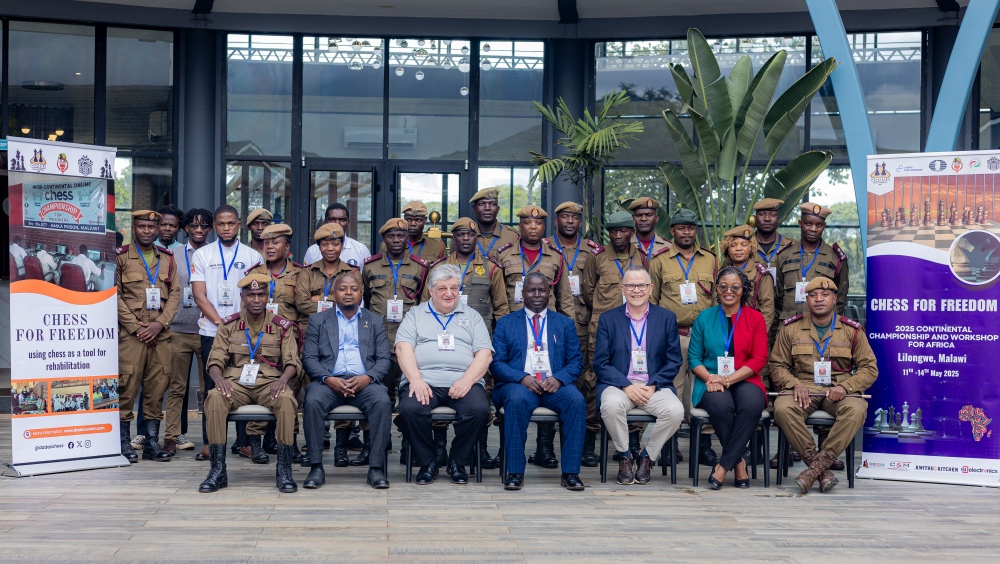
The FIDE “Chess for Freedom” program is the largest global initiative of the FIDE Social Commission. In the Year of Social Chess, each month highlights a specific social group, and May focuses on the “Chess for Freedom” initiative with two major continental conferences and tournaments—first in Malawi (Africa), followed immediately by another one in Mexico (Americas). The primary goal of these conferences is to expand the reach of the Chess for Freedom program from its current presence in 50 countries to over 60. This was the motivation behind organizing the African Conference in Lilongwe, Malawi, under the leadership of Susan Namangale, Dadaz Academy Chess Founder and Member of FIDE PDC Commission. The first day featured a workshop involving representatives from the FIDE Social Commission, officials from Malawi’s Prison Service, prison directors from across the country, and delegates from Ghana, Kenya, and the Malawi Chess Federation. Also in attendance were members of Dadaz, a local chess academy led by Susan Namangale, who also serves as a representative of Malawi’s Sports Council. The day included presentations, interactive discussions, fostering a collaborative and visionary atmosphere. The hybrid format allowed for international participation via Zoom. André Vögtlin, Chair of the FIDE Social Commission, praised the initiative as a well-established global project and expressed satisfaction with its successful introduction to Central and Southern Africa. He expressed hope that many new countries would now join the movement and participate in the 2025 Chess for Freedom World Championship in October. Vögtlin personally thanked Susan Namangale for her outstanding efforts and presented her with a certificate of recognition from the FIDE Social Commission. Susan Namangale emphasized that chess has a transformative effect on incarcerated individuals and sees her collaboration with Malawi’s prison system as a foundational element for expanding the Chess for Freedom program in the region. She expressed great satisfaction in witnessing the growth of social chess in Malawi. Project founder Mikhail Korenman expressed his delight with both the workshop and the subsequent championship, praising the exceptional organization. He highlighted the logistical achievement of safely transporting inmates from different prisons to the central venue—an approach that is rare globally. Both Korenman and Vögtlin noted that Malawi could serve as a role model for other African countries in the development of the Chess for Freedom initiative. The conference also showcased the success of partnerships, notably with Gift of Chess, in supplying chess sets. Maxwell Kamova, Assistant Commissioner of the Malawi Prison Service, stated that the chess program has had a profoundly positive impact on inmates, contributing to behavioral improvements. He mentioned that Malawi has specific guidelines for pardons and sentence reductions, and chess could potentially be used as a criterion for early release, given its role in promoting good behavior. The second day saw the African Continental Chess for Freedom Championship held at Maula Prison. Four teams from Malawi participated: two men’s teams, one women’s team, and a youth team. Additional teams from Zimbabwe, Ghana, and Kenya joined the tournament. Team Zimbabwe emerged victorious in the open section, followed closely by Malawi I and Malawi II. Malawi’s youth team was at a slight disadvantage due to a last-minute illness, yet home youngsters had a good showing, placing second, third, and ninth. André Vögtlin noted that the online Chess for Freedom format has proven effective for inter-prison competition, and that this championship served as an excellent trial run ahead of the global championship in October. Special thanks go to the technical team led by Nebojsa Baralic, who coordinated the online components of the tournament via Zoom and ensured smooth operations on chess.com. In closing, Mikhail Korenman stated: “Malawi is not only a strong partner for this project but for chess development in general.”
Changes to the World Rapid & Blitz format and a 1M euro prize fund

The International Chess Federation (FIDE) has announced a series of format enhancements and a one million euro prize fund for the 2025 World Rapid and Blitz Championships. Set to take place in Doha, Qatar, the World Rapid and Blitz Championships have become one of the most prestigious events on the international chess calendar since their official launch in 2012. Traditionally held in the last week of the year (from 26 to 31 December), the event attracts the best players in the world, including current world champions Gukesh Dommaraju and Ju Wenjun, as well as the world’s top-rated player, Magnus Carlsen, and a host of other heavyweights in both the Open and the Women’s competition. “We are very much looking forward to hosting the chess world in Doha and are happy to see FIDE has introduced important enhancements to the regulations,” said Mohd Al-Mudahka, President of the Qatar Chess Association. “We are committed to supporting chess, as we have shown with the Qatar Masters which has become one of the most prestigious chess tournaments globally. Doha also successfully hosted the World Rapid & Blitz Championships in 2016, and we are proud to welcome this flagship event back to our capital, further strengthening our place on the global chess map.” For the 2025 edition, the prize fund has been set at one million euros (approx. 1.125 million USD), maintaining the high financial standard of recent editions and reaffirming FIDE’s commitment to top level competition. The total will be split between the Open and Women’s events, with €700,000 allocated to the Open section — evenly divided between the Rapid and Blitz tournaments — and €300,000 for the Women’s section, also split equally. A new knockout format for the Blitz The two-day Blitz World Championship is the most watched and the most dramatic chess event of the year. In 2024, FIDE introduced a new knockout format in the Blitz that brought even more excitement to the event. In a significant structural shift, for 2025 FIDE is introducing a more streamlined knockout stage in the Blitz events in the Open and the Women’s sections. Only the top four players from the Swiss stage of the tournament will advance directly to the knockout semifinals (previously, eight players in both competitions qualified for the knockout). “The new format is an exciting mix of the Swiss system and knockout. The increased number of rounds in the qualifying part ensures that the strongest players will progress to the knockout. Also, the final match-up is ideally scheduled to suit audiences across all major chess hubs,” FIDE CEO and Grandmaster Emil Sutovsky said. “We are very excited about the event, and have already started preparations to produce the best quality broadcast for millions of spectators,” Sutovsky added. The Blitz schedule includes 19 Swiss rounds for the Open and 15 Swiss rounds for the Women, both played over two days, followed by semifinals and finals on December 30. The format for the Rapid World Championships remains unchanged, with 13 rounds in the Open and 11 in the Women’s competition, culminating in a playoff in case of a tie for first place. “With rapid and blitz formats gaining global popularity, the field is deeper and more competitive than ever,” said FIDE President Arkady Dvorkovich. “These format enhancements aim to make the event more dynamic while preserving the sport’s integrity and excitement for both players and fans.” Regulations for the 2025 World Rapid and Blitz events: Open – handbook.fide.com/files/handbook/wrbc_regulations_2025_open.pdf Women – handbook.fide.com/files/handbook/wrbc_regulations_2025_women.pdf
World’s largest chess queen erected in Río Ceballos, Argentina

Standing 7.62 meters tall, a giant chess queen now towers in the heart of Río Ceballos, Argentina. The application for official recognition by Guinness World Records has already been submitted. When Yanina Pepino showed her father Enrique a photo of a giant King chess piece in St. Louis, Missouri (USA), she never imagined how much it would inspire him. The moment Enrique saw the image on his phone, he began to envision creating another monumental chess piece—a Queen, but even bigger. Pepino, a well-known businessman originally from Santa Fe, has lived in Río Ceballos for many years. The wooden king in St. Louis, previously the largest chess piece in the world, measures 6.09 meters tall. The newly inaugurated queen surpasses it, standing at 7.62 meters, and the Guinness World Record recognition process is now underway. Enrique is also a graphic designer, and as he describes himself, a “pencil-and-paper designer.” He began sketching the queen—the most powerful piece on the board—with a vision for something entirely different. “It didn’t need to be wooden; it had to be something visually light, something that would blend into the landscape, not disrupt it. Obviously, it had to be more than 7 meters tall. So I started designing the Queen in the Staunton style, keeping its proportions,” he said. He concluded that iron would be the ideal material for the sculpture. “I did the drawings all in pencil, since I’m an old-school graphic designer. Then I outlined the segments for step-by-step construction. Once I had the plans, I invited my friend José Strasorier, a traditional iron craftsman, to build it together. He and a collaborator, Fernando Rotania, gave shape to the chess sculpture through handcrafted ironwork.” As for the color, there were only two options: black or white. “Naturally, we chose white because it offers better visibility, especially at night.” The project was privately funded and built, and is installed on private property in downtown Río Ceballos, directly across from the Chess School founded by Pepino. “The giant Queen is a symbol that will surely have a positive impact on chess in Córdoba. It will help raise awareness of the many benefits of this science game, and will position Córdoba as a national and international chess reference,” Pepino remarked. And his vision is gaining traction. At the inauguration, Mario Petrucci, Executive Director of the Argentine Chess Federation (FADA), proposed declaring Río Ceballos the chess capital of Argentina. He also conveyed a message by FIDE President Arkady Dvorkovich, who said: “This giant chess piece is not just a monument to our game but also to a great chess nation. Argentina’s place in chess history, both in Latin America and globally, is undeniable. It hosted important events, produced legends like Julio Bolbochán and Oscar Panno, and now inspires hope with rising stars like 11-year-old Faustino Oro. It is therefore fitting that such a visible chess landmark stands here in Río Ceballos, Córdoba, in the heart of the country! We also hope there will be more support for chess in Argentina and Latin America, so new talents could shine through!” Petrucci also took the opportunity to celebrate three centennials: 100 years of FADA (1922–2022) 100 years of the Argentine Olympic Committee (1923–2023) 100 years of the International Chess Federation (FIDE) (1924–2024) The ceremony was filled with emotion. Pepino expressed heartfelt gratitude to everyone who made the project possible—his children, his wife—and became emotional remembering his mother and grandmothers. Notable attendees included: Vice Governor Myrian Prunotto Río Ceballos Mayor Ezequiel Lemos President of the Córdoba Provincial Chess Federation, Guillermo Soppe FADA Executive Director Mario Petrucci Dorita Larrachea, President of Talent Academy of Chile International Masters María José Campos and Liliana Burijovich, along with other municipal and provincial officials. “What a brilliant move you made, Enrique! And how wonderful that it’s a Queen, symbolically highlighting all women’s struggles,” said Vice Governor Prunotto in her dedication to Pepino. The giant piece has already been officially recognized by the Municipality of Río Ceballos as a historic monument, and Vice Governor Prunotto supported the idea of turning the city into a provincial chess hub, including plans for an international tournament in honor of the giant queen. To round out the celebration, a giant-piece exhibition match was held at Paseo Humberto Francia between Masters Campos and Burijovich. On Sunday, María José Campos will also host simultaneous exhibition games on 25 boards. Source: lavoz.com.ar/ Photos: Federación Argentina de Ajedrez
The stage is set: Nearly 60 teams confirmed for the 2025 FIDE World Rapid & Blitz Team Championships in London

Registration has officially closed for the 2025 FIDE World Rapid & Blitz Team Championships, and it’s the biggest edition yet! With teams from every corner of the globe confirmed, this year’s event has attracted nearly 60 teams, a remarkable increase from the 38 who participated in 2024 and 36 in the inaugural 2023 edition (which featured only the Rapid competition). With average team ratings ranging from 1747 to 2695, the tournament truly represents the global chess community – uniting elite super grandmasters, rising stars, and ambitious amateurs. Let’s take a closer look at the top contenders in the line-up: Once again, WR Chess has assembled a dream team. Organised by Wadim Rosenstein, the reigning Blitz champions, and 2023 Rapid champions, return with a slightly different cast of familiar faces. While Magnus Carlsen led the team in 2024, this year’s roster includes Alireza Firouzja, Maxime Vachier-Lagrave, Hikaru Nakamura, and the returning Wesley So (from the 2023 edition). Also returning are Jan-Krzysztof Duda, and former Women’s World Champions Hou Yifan and Alexandra Kosteniuk. With so much firepower and fan appeal, WR Chess will once again be the team to watch. But with fierce competition ahead, winning both titles will be no easy feat. Ranked second on the starting list is another powerhouse: Hexamind Chess Team. The team boasts a lineup led by seasoned Grandmasters Levon Aronian, Leinier Dominguez Perez, Vladimir Kramnik, and Peter Svidler, players who have long defined elite chess. Complementing their experience are Indian stars Vidit Gujrathi and Divya Deshmukh, alongside David Muradyan. The balance of generations and styles gives this team real championship potential. The 2024 World Rapid Team Champions, Al-Ain ACMG UAE, are also back to defend their crown. With a core lineup featuring Vladislav Artemiev, Daniil Dubov, Dmitry Andreikin, Volodar Murzin, Kateryna Lagno, and Wafiya Darvish al-Maamari, the team remains one of the most formidable in the field. One notable change is the absence of Parham Maghsoodloo, who has switched sides this year to play for KazChess, the fourth-ranked team. There, he joins Richard Rapport and Alexander Grischuk in one of the tournament’s most intriguing rosters. This reshuffling of players is part of what makes this event so fascinating for spectators. Unlike the Olympiad, where national teams are fixed, this championship allows a mix of backgrounds, bringing together unexpected partnerships and rivalries and teams that have played together in the past may have an edge when it comes to synergy and coordination. Another crowd-favourite team is ranked fifth. Freedom is led on board one by none other than Viswanathan Anand. The five-time World Champion leads a rich lineup including Le Quang Liem, Samuel Sevian, Haik Martirosyan, Anna Muzychuk, Sarbartho Mani, Alexey Sarana, Rauf Mamedov, and Teodora Injac (fresh off her 2025 European Women’s Championship title). With other big names such as Arjun Erigaisi, Nodirbek Abdusattorov, and Vincent Keymer also in action, fans are guaranteed a feast of rapid-fire chess and high-stakes blitz battles. The full team list is available on the official website: worldrapidblitzteams2025.fide.com About the FIDE World Rapid and Blitz Team Championships Now in its third edition, the FIDE World Rapid & Blitz Team Championships will take place from June 10–16, 2025, at the Novotel London West, London. The event is open to national federations, clubs, cities, universities, companies, or any formally organized teams of six to nine players. Each team must include at least one female player and one recreational player (unrated or rated under 2000). The tournament begins with the Rapid competition, held from June 11–13, following a 12-round Swiss format with a time control of 15 minutes plus 10 seconds increment per move. This is followed by the Blitz tournament, which introduces a two-stage structure: a round-robin pool stage on June 14, and a knockout phase for the top 16 teams on June 15. Blitz games will be played with a time control of 3 minutes plus 2 seconds increment per move. With a record total prize fund of €500,000 (€310,000 allocated to Rapid and €190,000 to Blitz) this edition will be the richest in the event’s history. Medals will also be awarded for the best results on individual boards. For more information, visit the official website.
WGP Austria Round 6: Zhu and Tan shine in Grosslobming
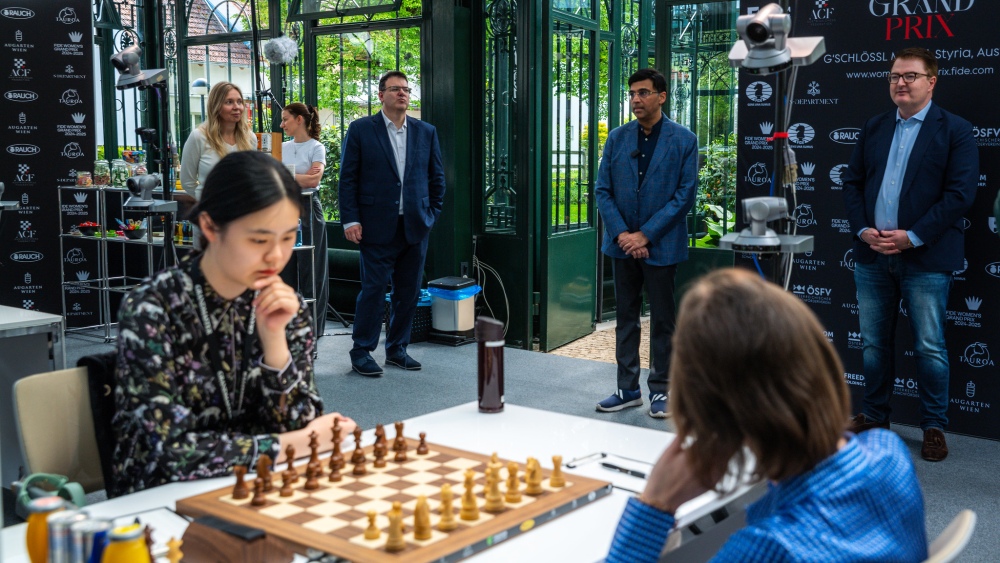
Chinese stars Zhu Jiner and Tan Zhongyi led the charge with crucial victories, while Alexandra Kosteniuk and Vaishali Rameshbabu also bounced back with important wins. For the best part of round six in the FIDE Women’s Grand Prix, it seemed that this would be a calm day on the chessboards. What began as a seemingly tranquil round turned into a thrilling display of sharp moves and nerves. Anna Muzychuk continues to lead with 4.5/6, after she drew with Nana Dzagnidze the only peaceful game of the day. Zhu Jiner scored her fourth victory, securing sole second place, half a point behind Anna. The two are the only players with a chance to win the overall 2024/2025 WGP season and get a spot in the 2026 Women’s Candidates. Congratulations go to former World Champion Tan Zhongyi, who ground down Salimova in what seemed to be a dead-drawn rook endgame. It was the longest game of the round, lasting five hours and 89 moves. The most intense game of the day was between Mariya Muzychuk and Zhu Jiner. In the Murphy Defence of Ruy Lopez, the position was even until the late stages of the middlegame when Muzychuk overlooked a tactical attack by Black. Mariya has just played the most natural move 31.Bg2? (after 31.Nh4 position is equal) but missed 31…Ndf4!! The knight is taboo – 32.gxf4 fails to 32…Nxf4 33.Re7 Nxg2 and if 34.Kxg2 then Qg4+, regaining piece, with a pawn advantage and a dominating position. White should have played 32.Qe3 here, defending the f3-knight, although, after 32…Rc3 her position is no fun. Instead, she blundered. 32.Rb1? Nxg2 33.Kxg2 Nf4+!! 34.Kg1 Nh3+ 35.Kg2 Rc2 36.Qe8+ Kh7 – and Black is completely winning. Although Zhu later gave Muzychuk a fleeting chance to equalise the Ukrainian missed her opportunity. Black should have proceeded with Nh3+ and g5, pressing and holding everything. Instead Zhu carelessly played 41…d5? giving respite to White in a position where she could almost not do anything! But Muzychuk erred. Instead of activating her knight with Nh4 and going for counterplay, she played 42.Qc3?, missing the only chance she got to save the game. In the next move, Zhu was on target – 42…g5! 43.Ne1 g4 44.Qd3 Removing the queens in the hope of a respite, but that didn’t help. 44…Qe4 45.Qxe4 dxe4 White ran out of moves. 46.Kh1 – giving up a pawn, but 46.d5 is met with 46…Rd2 followed by e4-e3) 46…Nxf2. The white king is in a mating web, and the pieces are pinned to the first rank. Five moves later Mariya capitulated. A well-deserved victory for Zhu – her fourth win in a row. Tan outlasts Salimova in a dead draw The second game that marked round six of the WGP in Austria was played by another Chinese – Tan Zhongyi, who defeated Bulgaria’s Nurgyul Salimova. After scoring her first victory in round five (an effective win against Kosteniuk), Nurgyul Salimova was in a buoyant mode against former World Champion Tan. Salimova played the King’s Indian Attack – an uncommon opening on grandmaster level. The Bulgarian was pushing on the queenside, but spent a lot of time thinking and didn’t succeed in creating any real opportunities. By move 28, the two transitioned to a rook endgame, where White had a 2:1 pawn advantage on the queenside. Still, Nurgyul had one major problem – time. With just six minutes on the clock (compared to Tan’s 46), Salimova needed to make 10 moves to reach the first time control, which isn’t easy in a rook endgame. Soon, a pair of rooks and pawns was exchanged. The two entered a rook endgame with White having a runner on the a-file. The position was even and everyone anticipated a quick draw. But Tan refused to settle. White soon abandoned her pawn, demonstrating the impregnability of her position, but Tan was determined to drain blood out of stone. And it eventually paid off. After White first lost her h-pawn, it was still a drawn endgame, but Tan had the psychological advantage. After 80 moves – 53 of which were spent on a rook endgame – Salimova finally broke. White should have moved her king to the corner with 81.Kh1, avoiding a double attack with …Rg2. If Black did go for 81..Rg2, she would then have a perpetual check from Black’s back ranks using the well known mad-rook motif. For example: 81.Kh1 Rg2 82.Rf8+ Ke5 83. Re8+ Kd5 84.Re5+! Kd4 (84..Kxe5 – stalemate!) 84.Rxe4+ and so on. However, Salimova played 81.Ra2?? and after 81…Rg2+ 82.Kh1 Kg4! Tan soon proceeded to take the second pawn and win. A remarkable show of perseverance from the former Women’s World Champion, who has so far had three victories, two defeats and one draw in the tournament. A great victory in a “miserable tournament” Another former Women’s World Champion – Alexandra Kosteniuk – also won. In the words of Grandmaster Emil Sutovsky, Kosteniuk had “a miserable tournament” so far – with just 1.5 points from five games. In round five she was upset by Salimova in a game where Kosteniuk had a significant advantage. Despite the shock, today she was back in good form and fighting spirit. Playing with the black pieces against Georgia’s Lela Javakhishvili, Kosteniuk achieved a solid position in the Colle system. As early as move 11, Javakhishvili gave up a pawn but got a sufficient compensation. On move 17, Black gave back the pawn but enjoyed a comfortable position. A few moves down the line, approaching time trouble – White made a heavy blunder. 23.Bb2? The optimal choice was to play 23.f3, giving up her d4-pawn but getting some activity after 23…Rxd4 25.Qb5. Any attempt to defend the d4-pawn is dangerous. As played, Black won the much more important e4-pawn after 23…Rxa1 24.Rxa1 Nxe4. Black has multiple things going in her favour: an extra pawn, a runner on the b-file, an excellent d5-square for the knight and the command of the c-file. White continued to resist, but Kosteniuk activated her king and broke

